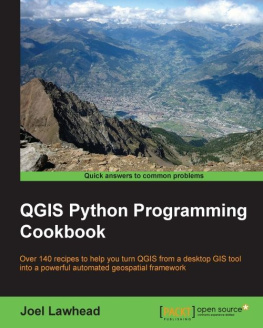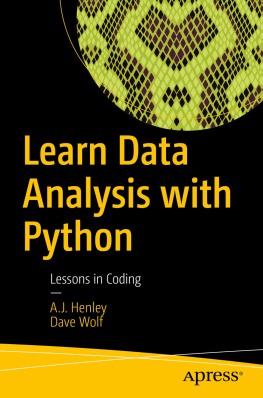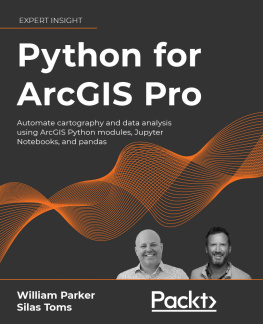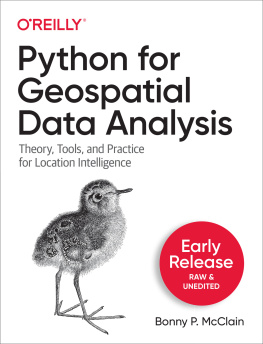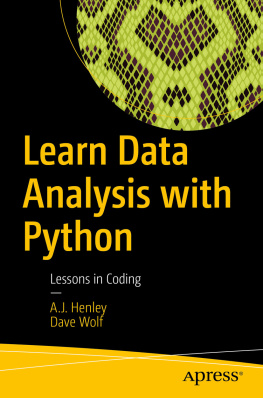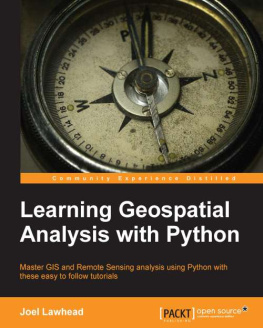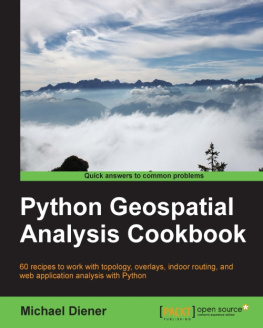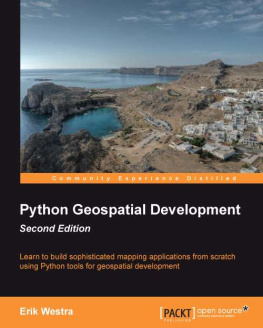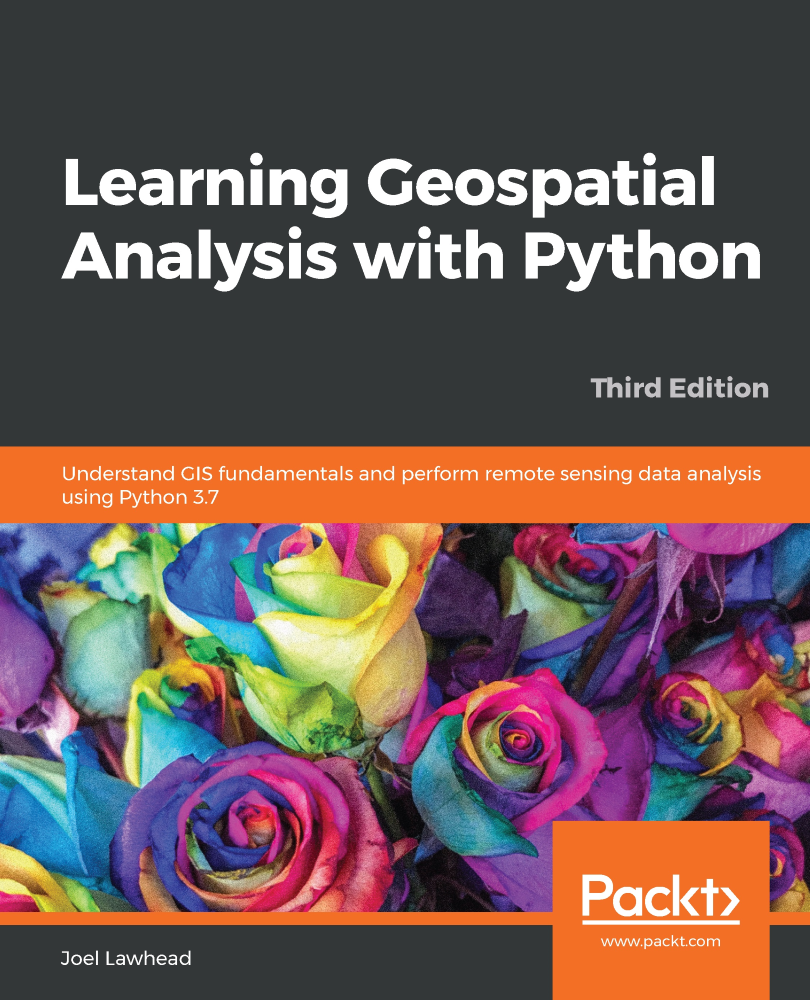Learning Geospatial Analysis with PythonThird Edition
Copyright 2019 Packt Publishing
All rights reserved. No part of this book may be reproduced, stored in a retrieval system, or transmitted in any form or by any means, without the prior written permission of the publisher, except in the case of brief quotations embedded in critical articles or reviews.
Every effort has been made in the preparation of this book to ensure the accuracy of the information presented. However, the information contained in this book is sold without warranty, either express or implied. Neither the author, nor Packt Publishing or its dealers and distributors, will be held liable for any damages caused or alleged to have been caused directly or indirectly by this book.
Packt Publishing has endeavored to provide trademark information about all of the companies and products mentioned in this book by the appropriate use of capitals. However, Packt Publishing cannot guarantee the accuracy of this information.
Commissioning Editor: Richa Tripathi
Acquisition Editor: Denim Pinto
Content Development Editor: Ruvika Rao
Senior Editor: Afshaan Khan
Technical Editor: Gaurav Gala
Copy Editor: Safis Editing
Project Coordinator: Prajakta Naik
Proofreader: Safis Editing
Indexer: Tejal Daruwale Soni
Production Designer: Jyoti Chauhan
First published: October 2013
Second edition: December 2015
Third edition: September 2019
Production reference: 1270919
Published by Packt Publishing Ltd.
Livery Place
35 Livery Street
Birmingham
B3 2PB, UK.
ISBN 978-1-78995-927-7
www.packt.com
To my wife, Julie, my coauthor of the incredible 22-year work of time, geography, and love that is our life.
To my children, Lauren, Will, Lillie, and Lainie, I love you all and hope each one of you hosts your own podcast one day that I can listen to on car trips.
To NVision Solutions, the team that first introduced me to geospatial technology almost 20 years ago and continues to create a challenging environment focused on continual learning and growth. Thank you Lalet, Craig, Amy, April, Joel "JJ" Herr, Mark, and Darren for all of the fun, interesting projects, and management meetings.
To the elite runners of the very prestigious Cedar Point Running Club, especially Robin, Leanne, and Mandy, for helping to collect sample GPS data for this book, and breaking up the long hours of coding, writing, and editing with brain-refreshing, soul-rejuvenating runs.
Packt.com
Subscribe to our online digital library for full access to over 7,000 books and videos, as well as industry leading tools to help you plan your personal development and advance your career. For more information, please visit our website.
Why subscribe?
Spend less time learning and more time coding with practical eBooks and Videos from over 4,000 industry professionals
Improve your learning with Skill Plans built especially for you
Get a free eBook or video every month
Fully searchable for easy access to vital information
Copy and paste, print, and bookmark content
Did you know that Packt offers eBook versions of every book published, with PDF and ePub files available? You can upgrade to the eBook version at www.packt.com and as a print book customer, you are entitled to a discount on the eBook copy. Get in touch with us at customercare@packtpub.com for more details.
At www.packt.com , you can also read a collection of free technical articles, sign up for a range of free newsletters, and receive exclusive discounts and offers on Packt books and eBooks.
Contributors
About the author
Joel Lawhead is a PMI-certified Project Management Professional, a certified GIS Professional, and the Chief Information Officer of NVision Solutions Inc., an award-winning firm specializing in geospatial technology integration and sensor engineering for NASA, FEMA, NOAA, the US Navy, and many other commercial and non-profit organizations. Joel began using Python in 1997 and started combining it with geospatial software development in 2000. He has authored multiple editions of Learning Geospatial Analysis with Python and QGIS Python Programming Cookbook, both from Packt. He is also the developer of the open source Python Shapefile Library (PyShp) and maintains a geospatial technical blog, GeospatialPython, and Twitter feed, @SpatialPython.
About the reviewer
Athanasios Tom Kralidis is a Senior Systems Scientist at the Meteorological Service of Canada, where he provides geospatial technical and architectural leadership in support of weather, climate and water data delivery. He is an active, long-time contributor to international standards and activities at the Open Geospatial Consortium and the World Meteorological Organization, as well as free and open source geospatial software and the Open Source Geospatial Foundation.
What this book covers
, Learning about Geospatial Analysis with Python , introduces geospatial analysis as a way of answering questions about our world. The differences between GIS and remote sensing are explained. Common geospatial analysis processes are demonstrated using illustrations, basic formulas, pseudo code, and Python.
, Learning Geospatial Data , explains the major categories of data and several newer formats that are becoming more and more common. Geospatial data comes in many forms. The most challenging part of geospatial analysis is acquiring the data that you need and preparing it for analysis. Familiarity with these data types is essential to understanding geospatial analysis.
, The Geospatial Technology Landscape , tells you about the geospatial technology ecosystem, which consists of thousands of software libraries and packages. This vast array of choices is overwhelming for newcomers to geospatial analysis. The secret to learning geospatial analysis quickly is understanding the handful of libraries and packages that really matter. Most other software is derived from these critical packages. Understanding the hierarchy of geospatial software and how it's used allows you to quickly comprehend and evaluate any geospatial tool.
, Learning about Geospatial Analysis with Python , are also demonstrated in this chapter.
, Python and Geographic Information Systems , teaches you about simple yet practical Python GIS geospatial products using processes that can be applied to a variety of problems.
, Python and Remote Sensing , shows you how to work with remote sensing geospatial data. Remote sensing includes some of the most complex and least-documented geospatial operations. This chapter will build a solid core for you and demystify remote sensing using Python.


